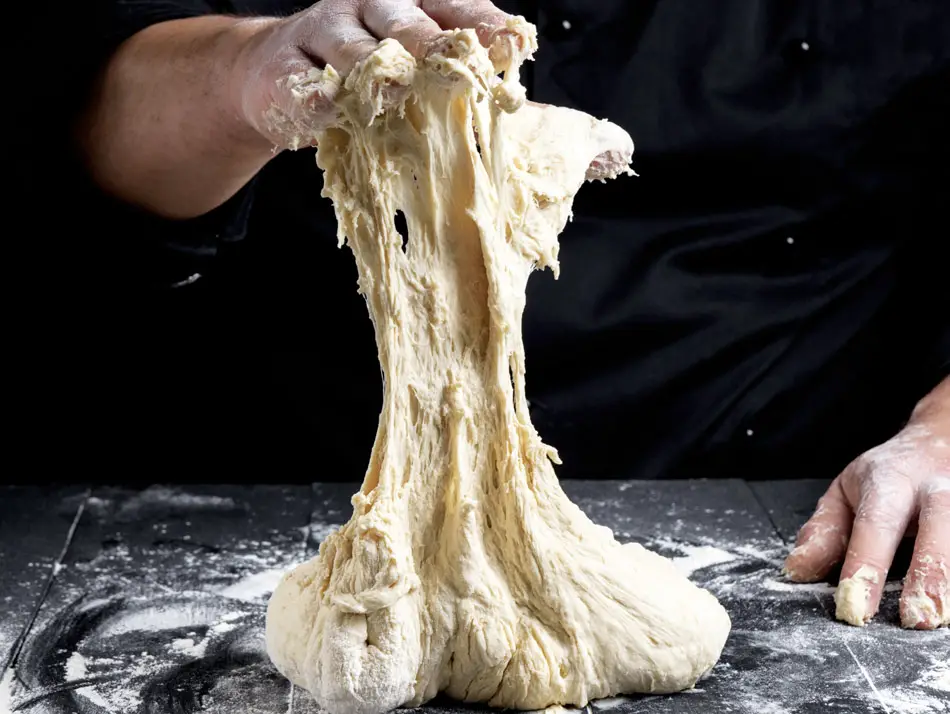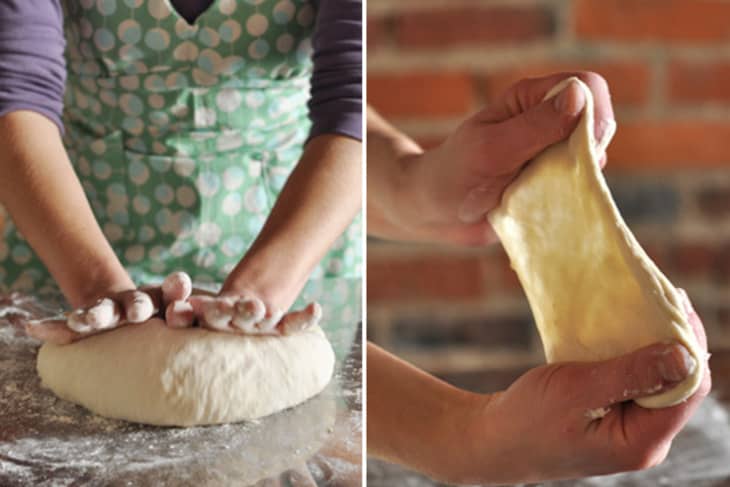Slight variation in the ingredients or mixing process can change the composition of the dough wildly. And because of that you have a dough that is tacky.
So what to do with tacky dough?
Tacky dough is great for making pizza, pastry, pasta, and other delicious foods. Overhydration, insufficient needling, moisture in the air can affect the tackiness of the dough. You can make the dough less tacky by adding more flour or removing moisture.
So that’s what you may do with tacky dough. But that’s not all. We would also discuss what else can be done, how to best use tacky dough and how to recognize. So stay with us!
Recognizing Tacky Dough
So, what is tacky? When discussing the consistency of dough, the term “tacky” refers to a consistency that is adhesive or slightly sticky. Because of this, the dough may be difficult to handle, shape, and otherwise work with.
The amount of water or other liquids used in the recipe, the mixing and kneading process, as well as environmental factors such as humidity and temperature, can all contribute to the dough having a sticky feel.
How do you know if dough is tacky?

You can feel the dough with your fingertips to determine whether or not it is tacky. Your fingertips will experience a minor sticking or clinging sensation when handling tacky dough. But, tacky dough will not leave a residue on your hands, whereas sticky dough will.
The picture above is an example of sticky dough. But tacky dough doesn’t stick like this to the hands. They stick but come off without leaving anything on the hands.
But tacky dough may be a pain to deal with too. That is since it makes it more difficult to get the shape and texture you want for your baked goods.
Tackiness in dough is beneficial to some degree. Because it can help the dough adhere together and make it easier to shape and roll. But too much tackiness can be problematic.
Why Is The Dough Tacky?
Dough can become tacky because of overhydration, bad mixing, moisture, type of flours and other ingredients.
Overhydration:
Overhydration is one of the most common reasons why dough can become tacky. Too much water or other liquid may be added to the dough. It can create a sticky texture that is difficult to work with.
This can happen if the recipe measurements are not precise. Or if the dough is left to rest in a humid environment where it absorbs excess moisture.
Insufficient mixing or kneading:
Dough can become tacky if it is not mixed or kneaded properly. If the ingredients are not evenly distributed throughout the dough, it can create pockets of moisture or dryness. These can cause the dough to stick together or tear.
This can happen if the dough is not kneaded for long enough, or if the mixing process is not thorough.
Environmental factors:
The environment in which the dough is made can also impact its texture and stickiness. High humidity or high temperatures can cause the dough to become tacky. That is because moisture from the air can be absorbed by the dough.
Type of flour used:
The type of flour used in a recipe can also impact the texture of the dough. Certain types of flour, such as whole wheat flour or rye flour, have a higher gluten content than all-purpose flour. This can make the dough stickier and more difficult to work with.
Other ingredients:
In some cases, the other ingredients used in a recipe can also impact the texture of the dough. For example, adding too much sugar or honey can create a sticky texture. Meanwhile, using too little fat can make the dough dry and crumbly.
Is Tacky Dough Good or Bad?
Whether tacky dough is good or bad depends on the type of food being made and personal preference. In some cases, a slightly tacky dough can be desirable. For example, some pizza makers prefer a slightly tacky dough as it can help the dough stretch more easily. And it creates a thin, crispy crust.
So when is tacky dough better? Tacky dough is better for making pizza, pastry and pasta. We will see why tacky dough is better for making these food items in a later section.
On the other hand, too much tackiness can be problematic and result in dough that is difficult to handle and shape.
So which food items should not have a tacky dough?
Bread: When making bread, a very tacky dough can result in bread that is dense and heavy. A more elastic and less tacky dough is preferred for making bread. Because it can create a lighter, more airy texture.
So tacky dough is not suited for any kind of breads, even elvish breads.
Cookies: A very tacky cookie dough can result in cookies that spread too much and become thin and crispy instead of soft and chewy. A dryer, less tacky cookie dough is preferred.
Dumplings: Tacky dough is not good for dumplings. When making dumpling dough, you want a smooth, soft, and supple dough
What is the Difference Between Sticky and Tacky Dough?
Sticky dough is able or likely to stick to the finger and leave a residue. But tacky dough will adhere to your finger but will release it without leaving much of a trace.
Sticky dough refers to dough that adheres to surfaces or hands but does not leave a residue or feel slightly gummy to the touch. Sticky dough can often be remedied by dusting with flour or adding more flour to the dough.
Tacky dough, on the other hand, refers to dough that feels slightly gummy or sticky to the touch and leaves a residue on surfaces or hands. Tacky dough is usually the result of too much liquid in the dough and can be more difficult to remedy than sticky dough.
Comparing tacky dough to other kinds of dough, we can say that it is different from dry or stiff dough. Dry dough, as the name suggests, has too little moisture. And can result in dough that is difficult to shape or roll out.
Wet dough, on the other hand, has a high level of moisture but is not necessarily tacky or sticky. Wet dough is often used in artisan bread making to create a more open crumb structure.
How Do You Fix Tacky Dough?
There are multiple ways to fix your tacky dough.
Add more flour:
If the dough is only slightly tacky, you can try adding a little bit more flour to it. This will cancel out the excess water present in the dough.
Start by adding small amounts of flour at a time and knead the dough thoroughly between each addition. Keep doing it until you reach the desired consistency.
Let the dough rest:
If the dough is too sticky to work with, let it rest for 10-15 minutes. This is to allow the flour to absorb the moisture. As the moisture lessens, the dough will become less tacky and easier to handle.
Adjust the liquid:
If the dough is too tacky, it may be because there is too much liquid. We already discussed overhydration as the main cause of tacky dough. So try reducing the amount of liquid in the recipe or adding more flour to balance it out.
Follow the recipe:
Following the recipe is an important step to ensure that your dough comes out correctly. When making dough, it’s important to measure your ingredients accurately and follow the recipe’s instructions closely.
Use a dough scraper:
If the dough is sticking to your hands or work surface, use a dough scraper to help lift and move the dough without touching it directly. Kneading properly will help adjust the tackiness of the dough. A dough scrapper is very useful in this case.
Refrigerate the dough:
If all else fails, you can try refrigerating the dough for 30 minutes to an hour to firm it up. This will dry out the moisture and make it easier to work with.
What Can You Do With Tacky Dough?
Tacky dough can be challenging to work with, but it can also be versatile and used for a variety of recipes.
One of the benefits of tacky dough is that it can often result in a more tender and flavorful end product. The extra moisture in the dough can help create a more moist and flavorful finished product. Especially when it’s pizza, pastry, or pasta. Additionally, the stretchiness of tacky dough can help create a more satisfying texture when eaten.

Make Pizza:
Tacky dough is great for making pizza because it has a tendency to be more stretchy and pliable. This makes it easier to shape and stretch into the desired shape and thickness for your pizza crust. Additionally, tacky dough tends to be more moist, which can help create a chewy and flavorful crust.
Be careful while using tacky dough so that it doesn’t leave a flying crust.
Make Pastry:
Tacky dough can also be great for making pastries such as croissants, danishes, and turnovers. The extra moisture in the dough can help create flaky, tender layers in the pastry.
If you try to make choux pastry with tacky dough and mess up, there are ways to make amends with messed up choux pastry.
Make Pasta:
Tacky dough is a common type of dough used for making fresh pasta. The extra moisture in the dough helps it stick together and hold its shape when rolled out and cut into various shapes. Additionally, the stretchiness of tacky dough can make it easier to work with when rolling and shaping pasta.
Frequently Asked Questions (FAQs)
Should pizza dough be soft or sticky?
Pizza dough can be a little bit both soft and slightly tacky, but it shouldn’t be overly sticky or wet. Ideally, pizza dough should be smooth and elastic, and easy to handle without sticking to your hands or work surface
Will sticky dough rise?
Yes, sticky dough will rise but it may not rise as well as tacky dough because the glutens in the bread are underdeveloped. A slightly tacky dough can be beneficial for the rising process, as it can help the dough stretch and rise more easily.
Does humidity make dough sticky?
Yes, humidity can make dough sticky. When the air is humid, it contains more moisture, this can make the dough more sticky. So you may need to adjust your recipes a little depending on the environment.
Conclusion
And with that we know so much more about tacky dough now. We know all about how it feels and what makes the dough extra tacky.
Tacky dough is not necessarily bad and it can be put to good baking use.





